Report: Organisational Behaviour, Leadership, and Team Building at M&S
VerifiedAdded on 2021/01/03
|14
|3725
|255
Report
AI Summary
This report examines the organisational behaviour, leadership, and people management practices at Marks and Spencer (M&S). It defines key concepts such as motivation, team building, and leadership, and explores relevant theories. The report delves into the theories of motivation, including Maslow's hierarchy of needs and the ERG theory, highlighting their application within M&S. It also analyses team building and development through Tuckman's Five Stage Team Development theory and Kormanski & Mozenter Stages of Team Development. Furthermore, the report discusses leadership theories, specifically behavioural and contingency theories, and their relevance to M&S. The importance of Tuckman's and Maslow's theories for M&S is emphasized, providing a comprehensive overview of the organisation's approach to managing its workforce and achieving its goals. This report is a valuable resource for students studying organisational behaviour and leadership management, offering insights into real-world applications of these concepts.
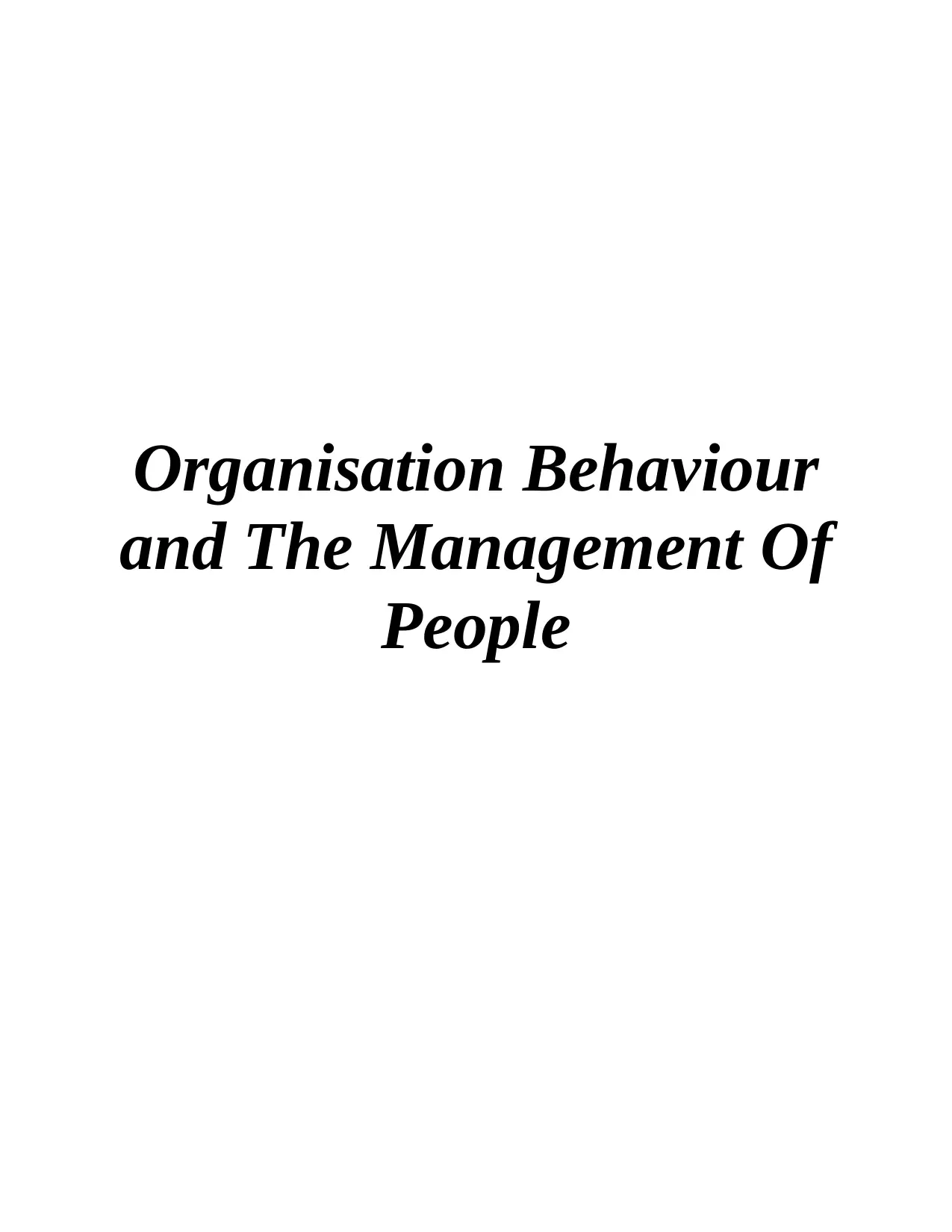
Organisation Behaviour
and The Management Of
People
and The Management Of
People
Paraphrase This Document
Need a fresh take? Get an instant paraphrase of this document with our AI Paraphraser
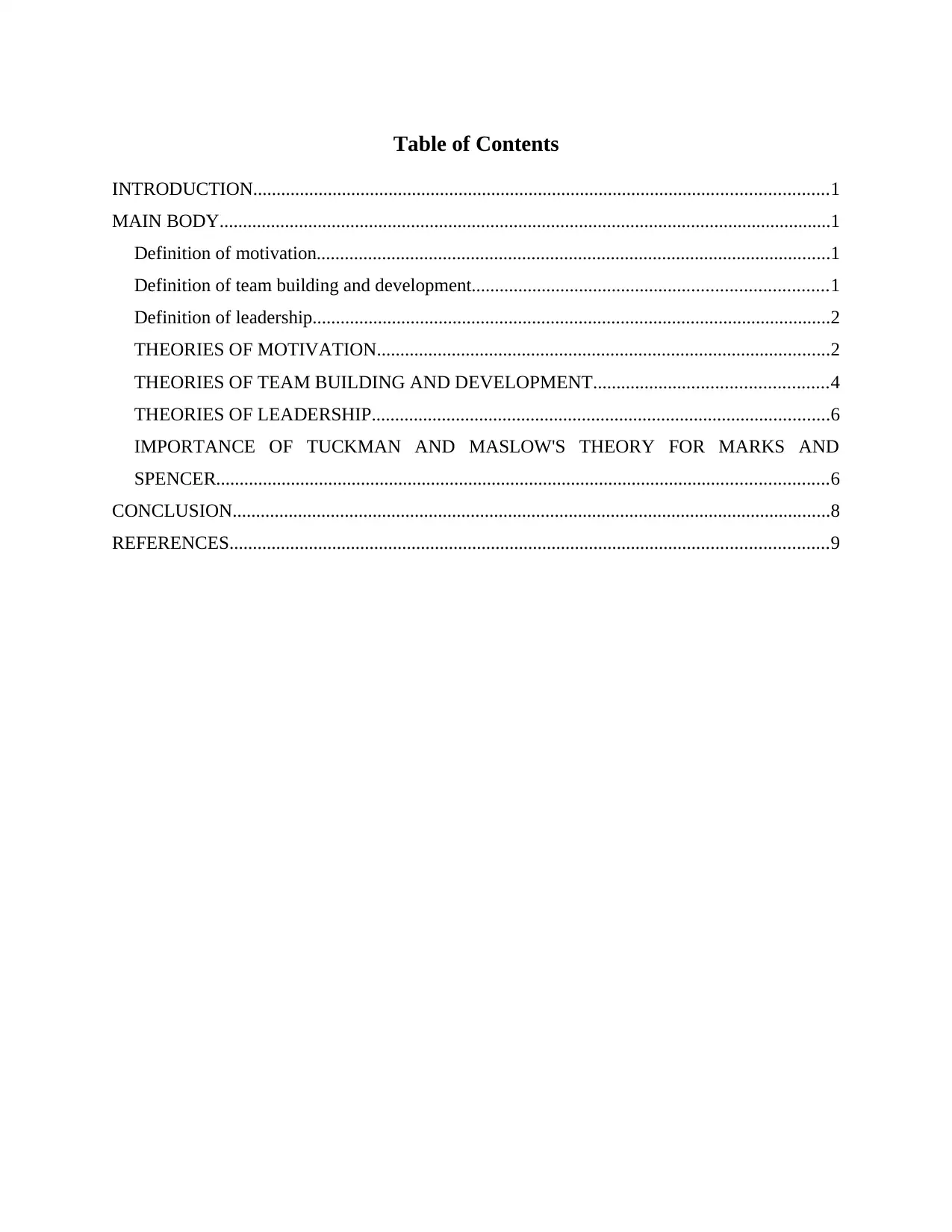
Table of Contents
INTRODUCTION...........................................................................................................................1
MAIN BODY...................................................................................................................................1
Definition of motivation..............................................................................................................1
Definition of team building and development............................................................................1
Definition of leadership...............................................................................................................2
THEORIES OF MOTIVATION.................................................................................................2
THEORIES OF TEAM BUILDING AND DEVELOPMENT..................................................4
THEORIES OF LEADERSHIP..................................................................................................6
IMPORTANCE OF TUCKMAN AND MASLOW'S THEORY FOR MARKS AND
SPENCER...................................................................................................................................6
CONCLUSION................................................................................................................................8
REFERENCES................................................................................................................................9
INTRODUCTION...........................................................................................................................1
MAIN BODY...................................................................................................................................1
Definition of motivation..............................................................................................................1
Definition of team building and development............................................................................1
Definition of leadership...............................................................................................................2
THEORIES OF MOTIVATION.................................................................................................2
THEORIES OF TEAM BUILDING AND DEVELOPMENT..................................................4
THEORIES OF LEADERSHIP..................................................................................................6
IMPORTANCE OF TUCKMAN AND MASLOW'S THEORY FOR MARKS AND
SPENCER...................................................................................................................................6
CONCLUSION................................................................................................................................8
REFERENCES................................................................................................................................9
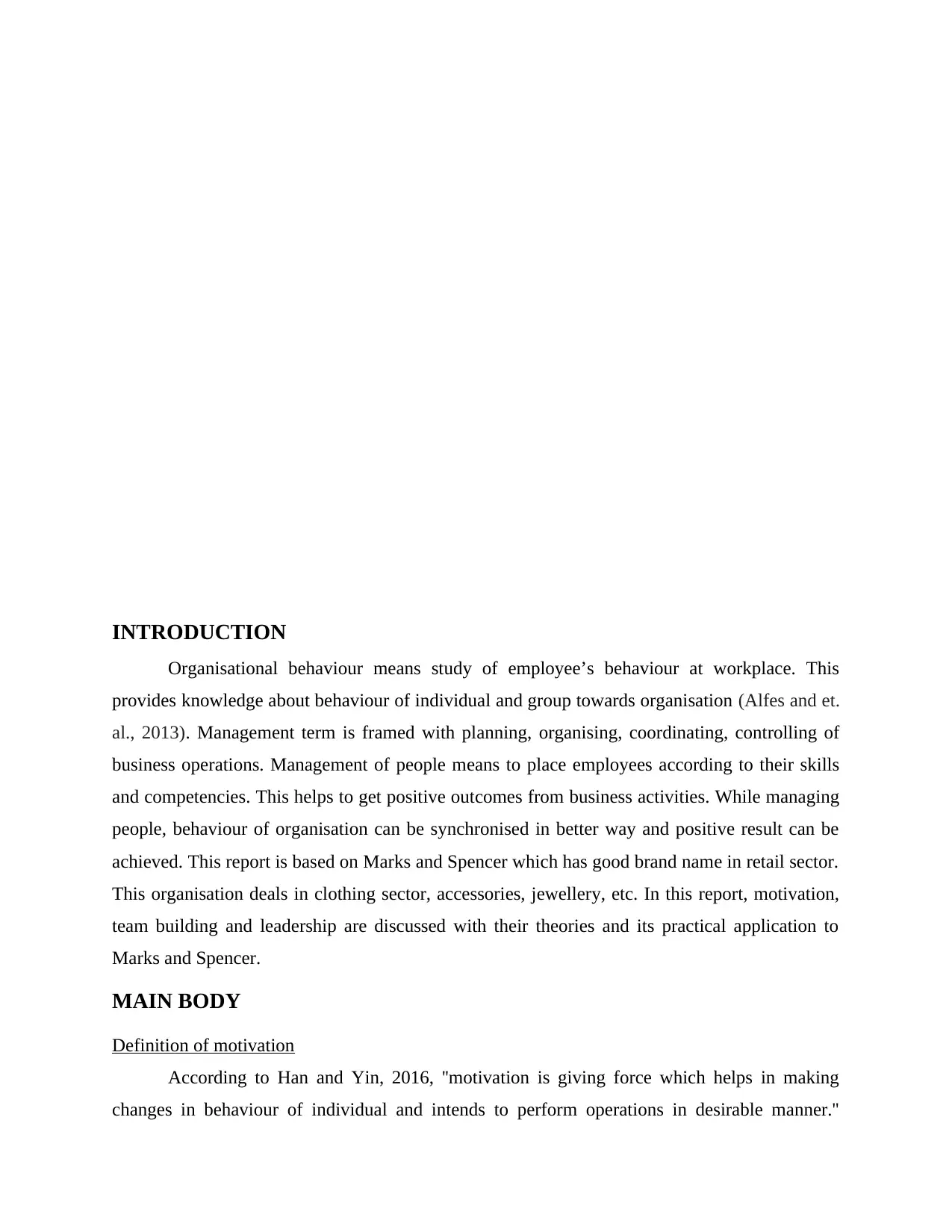
INTRODUCTION
Organisational behaviour means study of employee’s behaviour at workplace. This
provides knowledge about behaviour of individual and group towards organisation (Alfes and et.
al., 2013). Management term is framed with planning, organising, coordinating, controlling of
business operations. Management of people means to place employees according to their skills
and competencies. This helps to get positive outcomes from business activities. While managing
people, behaviour of organisation can be synchronised in better way and positive result can be
achieved. This report is based on Marks and Spencer which has good brand name in retail sector.
This organisation deals in clothing sector, accessories, jewellery, etc. In this report, motivation,
team building and leadership are discussed with their theories and its practical application to
Marks and Spencer.
MAIN BODY
Definition of motivation
According to Han and Yin, 2016, ''motivation is giving force which helps in making
changes in behaviour of individual and intends to perform operations in desirable manner.''
Organisational behaviour means study of employee’s behaviour at workplace. This
provides knowledge about behaviour of individual and group towards organisation (Alfes and et.
al., 2013). Management term is framed with planning, organising, coordinating, controlling of
business operations. Management of people means to place employees according to their skills
and competencies. This helps to get positive outcomes from business activities. While managing
people, behaviour of organisation can be synchronised in better way and positive result can be
achieved. This report is based on Marks and Spencer which has good brand name in retail sector.
This organisation deals in clothing sector, accessories, jewellery, etc. In this report, motivation,
team building and leadership are discussed with their theories and its practical application to
Marks and Spencer.
MAIN BODY
Definition of motivation
According to Han and Yin, 2016, ''motivation is giving force which helps in making
changes in behaviour of individual and intends to perform operations in desirable manner.''
⊘ This is a preview!⊘
Do you want full access?
Subscribe today to unlock all pages.

Trusted by 1+ million students worldwide
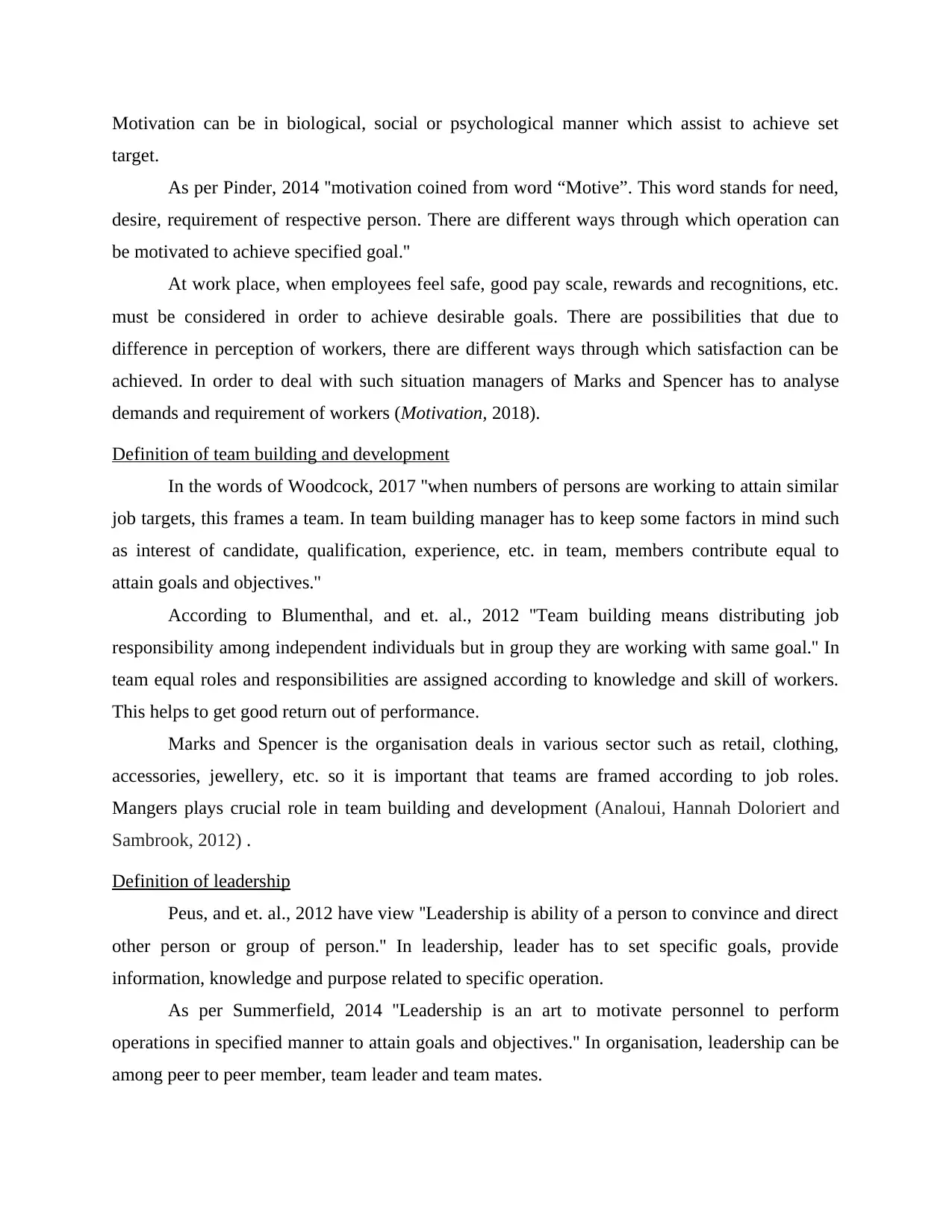
Motivation can be in biological, social or psychological manner which assist to achieve set
target.
As per Pinder, 2014 ''motivation coined from word “Motive”. This word stands for need,
desire, requirement of respective person. There are different ways through which operation can
be motivated to achieve specified goal.''
At work place, when employees feel safe, good pay scale, rewards and recognitions, etc.
must be considered in order to achieve desirable goals. There are possibilities that due to
difference in perception of workers, there are different ways through which satisfaction can be
achieved. In order to deal with such situation managers of Marks and Spencer has to analyse
demands and requirement of workers (Motivation, 2018).
Definition of team building and development
In the words of Woodcock, 2017 ''when numbers of persons are working to attain similar
job targets, this frames a team. In team building manager has to keep some factors in mind such
as interest of candidate, qualification, experience, etc. in team, members contribute equal to
attain goals and objectives.''
According to Blumenthal, and et. al., 2012 ''Team building means distributing job
responsibility among independent individuals but in group they are working with same goal.'' In
team equal roles and responsibilities are assigned according to knowledge and skill of workers.
This helps to get good return out of performance.
Marks and Spencer is the organisation deals in various sector such as retail, clothing,
accessories, jewellery, etc. so it is important that teams are framed according to job roles.
Mangers plays crucial role in team building and development (Analoui, Hannah Doloriert and
Sambrook, 2012) .
Definition of leadership
Peus, and et. al., 2012 have view ''Leadership is ability of a person to convince and direct
other person or group of person.'' In leadership, leader has to set specific goals, provide
information, knowledge and purpose related to specific operation.
As per Summerfield, 2014 ''Leadership is an art to motivate personnel to perform
operations in specified manner to attain goals and objectives.'' In organisation, leadership can be
among peer to peer member, team leader and team mates.
target.
As per Pinder, 2014 ''motivation coined from word “Motive”. This word stands for need,
desire, requirement of respective person. There are different ways through which operation can
be motivated to achieve specified goal.''
At work place, when employees feel safe, good pay scale, rewards and recognitions, etc.
must be considered in order to achieve desirable goals. There are possibilities that due to
difference in perception of workers, there are different ways through which satisfaction can be
achieved. In order to deal with such situation managers of Marks and Spencer has to analyse
demands and requirement of workers (Motivation, 2018).
Definition of team building and development
In the words of Woodcock, 2017 ''when numbers of persons are working to attain similar
job targets, this frames a team. In team building manager has to keep some factors in mind such
as interest of candidate, qualification, experience, etc. in team, members contribute equal to
attain goals and objectives.''
According to Blumenthal, and et. al., 2012 ''Team building means distributing job
responsibility among independent individuals but in group they are working with same goal.'' In
team equal roles and responsibilities are assigned according to knowledge and skill of workers.
This helps to get good return out of performance.
Marks and Spencer is the organisation deals in various sector such as retail, clothing,
accessories, jewellery, etc. so it is important that teams are framed according to job roles.
Mangers plays crucial role in team building and development (Analoui, Hannah Doloriert and
Sambrook, 2012) .
Definition of leadership
Peus, and et. al., 2012 have view ''Leadership is ability of a person to convince and direct
other person or group of person.'' In leadership, leader has to set specific goals, provide
information, knowledge and purpose related to specific operation.
As per Summerfield, 2014 ''Leadership is an art to motivate personnel to perform
operations in specified manner to attain goals and objectives.'' In organisation, leadership can be
among peer to peer member, team leader and team mates.
Paraphrase This Document
Need a fresh take? Get an instant paraphrase of this document with our AI Paraphraser
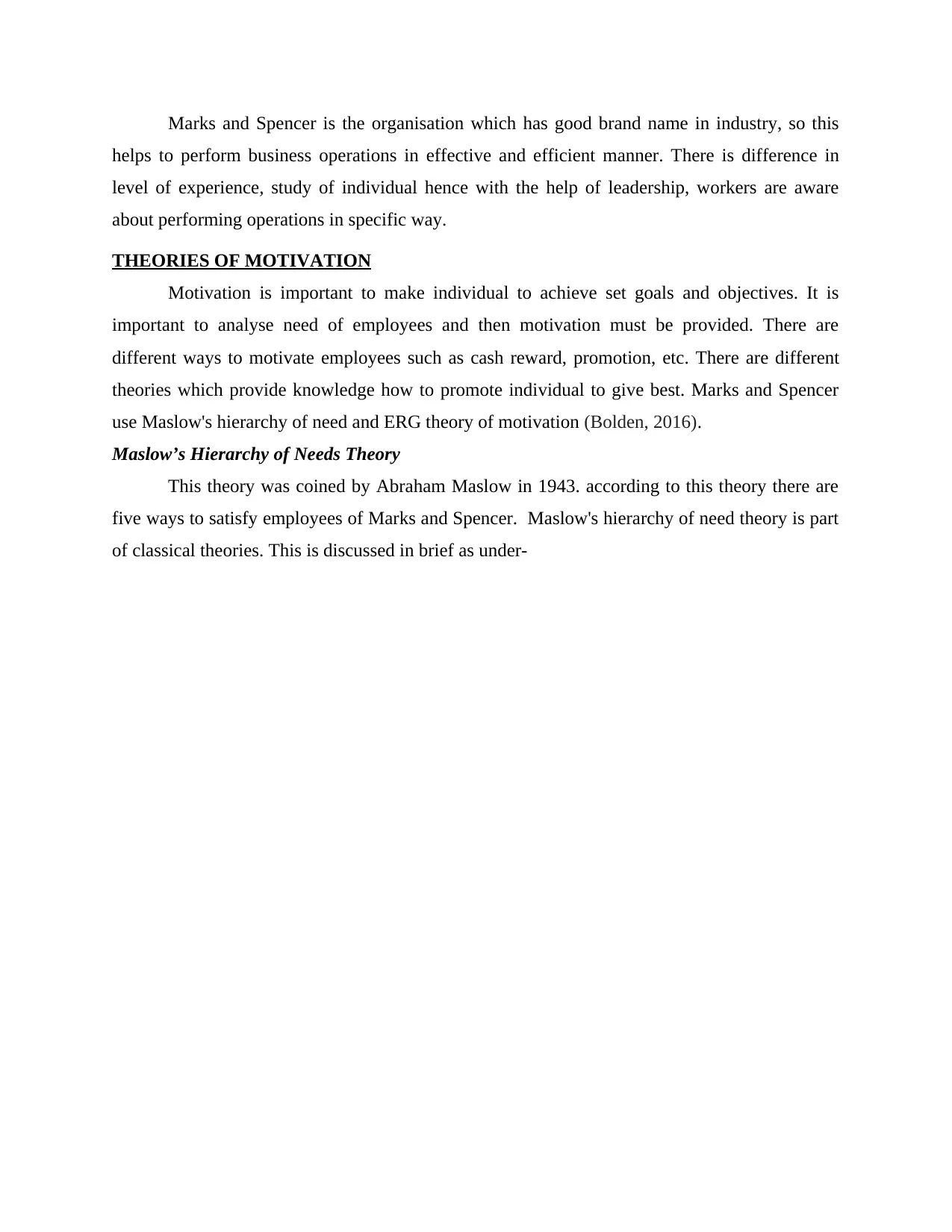
Marks and Spencer is the organisation which has good brand name in industry, so this
helps to perform business operations in effective and efficient manner. There is difference in
level of experience, study of individual hence with the help of leadership, workers are aware
about performing operations in specific way.
THEORIES OF MOTIVATION
Motivation is important to make individual to achieve set goals and objectives. It is
important to analyse need of employees and then motivation must be provided. There are
different ways to motivate employees such as cash reward, promotion, etc. There are different
theories which provide knowledge how to promote individual to give best. Marks and Spencer
use Maslow's hierarchy of need and ERG theory of motivation (Bolden, 2016).
Maslow’s Hierarchy of Needs Theory
This theory was coined by Abraham Maslow in 1943. according to this theory there are
five ways to satisfy employees of Marks and Spencer. Maslow's hierarchy of need theory is part
of classical theories. This is discussed in brief as under-
helps to perform business operations in effective and efficient manner. There is difference in
level of experience, study of individual hence with the help of leadership, workers are aware
about performing operations in specific way.
THEORIES OF MOTIVATION
Motivation is important to make individual to achieve set goals and objectives. It is
important to analyse need of employees and then motivation must be provided. There are
different ways to motivate employees such as cash reward, promotion, etc. There are different
theories which provide knowledge how to promote individual to give best. Marks and Spencer
use Maslow's hierarchy of need and ERG theory of motivation (Bolden, 2016).
Maslow’s Hierarchy of Needs Theory
This theory was coined by Abraham Maslow in 1943. according to this theory there are
five ways to satisfy employees of Marks and Spencer. Maslow's hierarchy of need theory is part
of classical theories. This is discussed in brief as under-
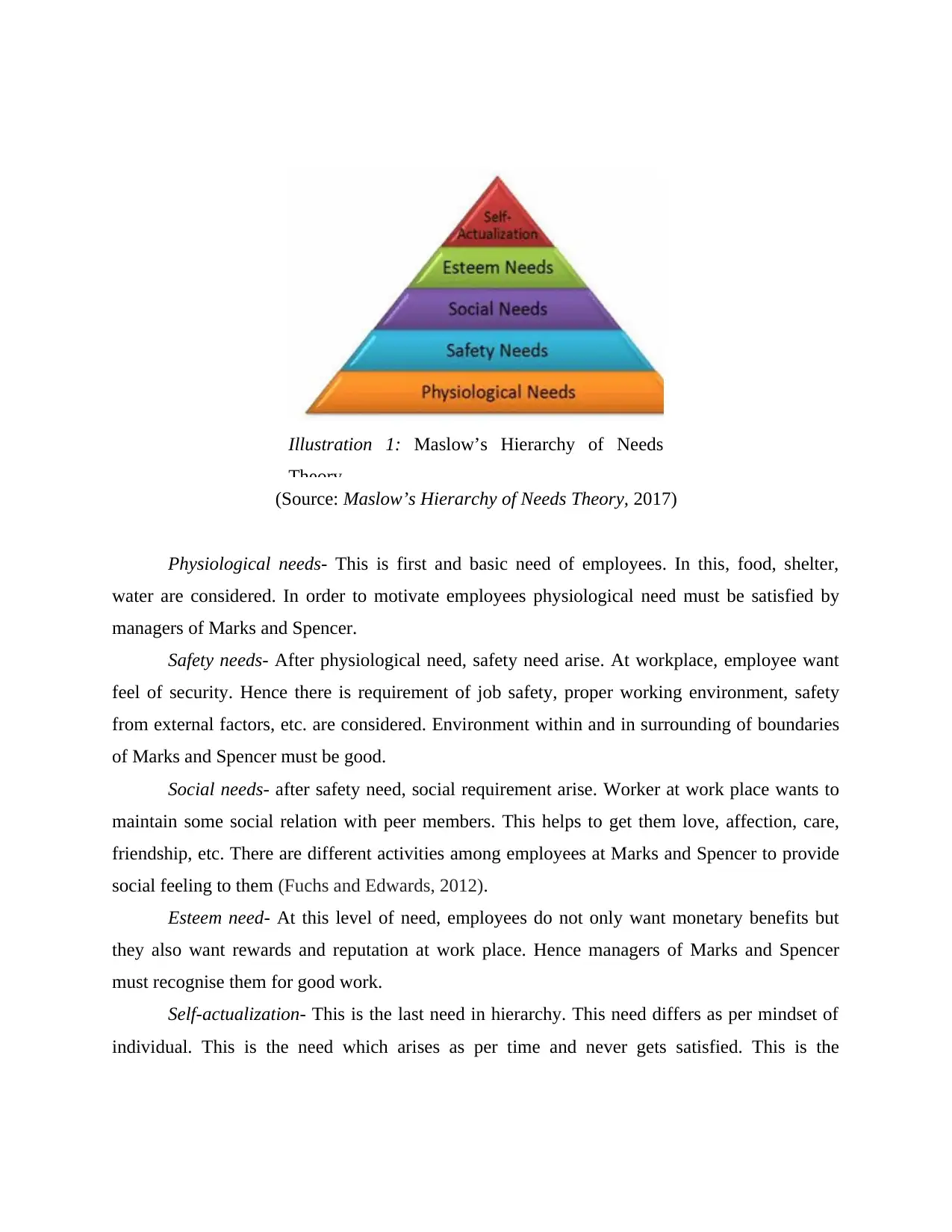
(Source: Maslow’s Hierarchy of Needs Theory, 2017)
Physiological needs- This is first and basic need of employees. In this, food, shelter,
water are considered. In order to motivate employees physiological need must be satisfied by
managers of Marks and Spencer.
Safety needs- After physiological need, safety need arise. At workplace, employee want
feel of security. Hence there is requirement of job safety, proper working environment, safety
from external factors, etc. are considered. Environment within and in surrounding of boundaries
of Marks and Spencer must be good.
Social needs- after safety need, social requirement arise. Worker at work place wants to
maintain some social relation with peer members. This helps to get them love, affection, care,
friendship, etc. There are different activities among employees at Marks and Spencer to provide
social feeling to them (Fuchs and Edwards, 2012).
Esteem need- At this level of need, employees do not only want monetary benefits but
they also want rewards and reputation at work place. Hence managers of Marks and Spencer
must recognise them for good work.
Self-actualization- This is the last need in hierarchy. This need differs as per mindset of
individual. This is the need which arises as per time and never gets satisfied. This is the
Illustration 1: Maslow’s Hierarchy of Needs
Theory
Physiological needs- This is first and basic need of employees. In this, food, shelter,
water are considered. In order to motivate employees physiological need must be satisfied by
managers of Marks and Spencer.
Safety needs- After physiological need, safety need arise. At workplace, employee want
feel of security. Hence there is requirement of job safety, proper working environment, safety
from external factors, etc. are considered. Environment within and in surrounding of boundaries
of Marks and Spencer must be good.
Social needs- after safety need, social requirement arise. Worker at work place wants to
maintain some social relation with peer members. This helps to get them love, affection, care,
friendship, etc. There are different activities among employees at Marks and Spencer to provide
social feeling to them (Fuchs and Edwards, 2012).
Esteem need- At this level of need, employees do not only want monetary benefits but
they also want rewards and reputation at work place. Hence managers of Marks and Spencer
must recognise them for good work.
Self-actualization- This is the last need in hierarchy. This need differs as per mindset of
individual. This is the need which arises as per time and never gets satisfied. This is the
Illustration 1: Maslow’s Hierarchy of Needs
Theory
⊘ This is a preview!⊘
Do you want full access?
Subscribe today to unlock all pages.

Trusted by 1+ million students worldwide
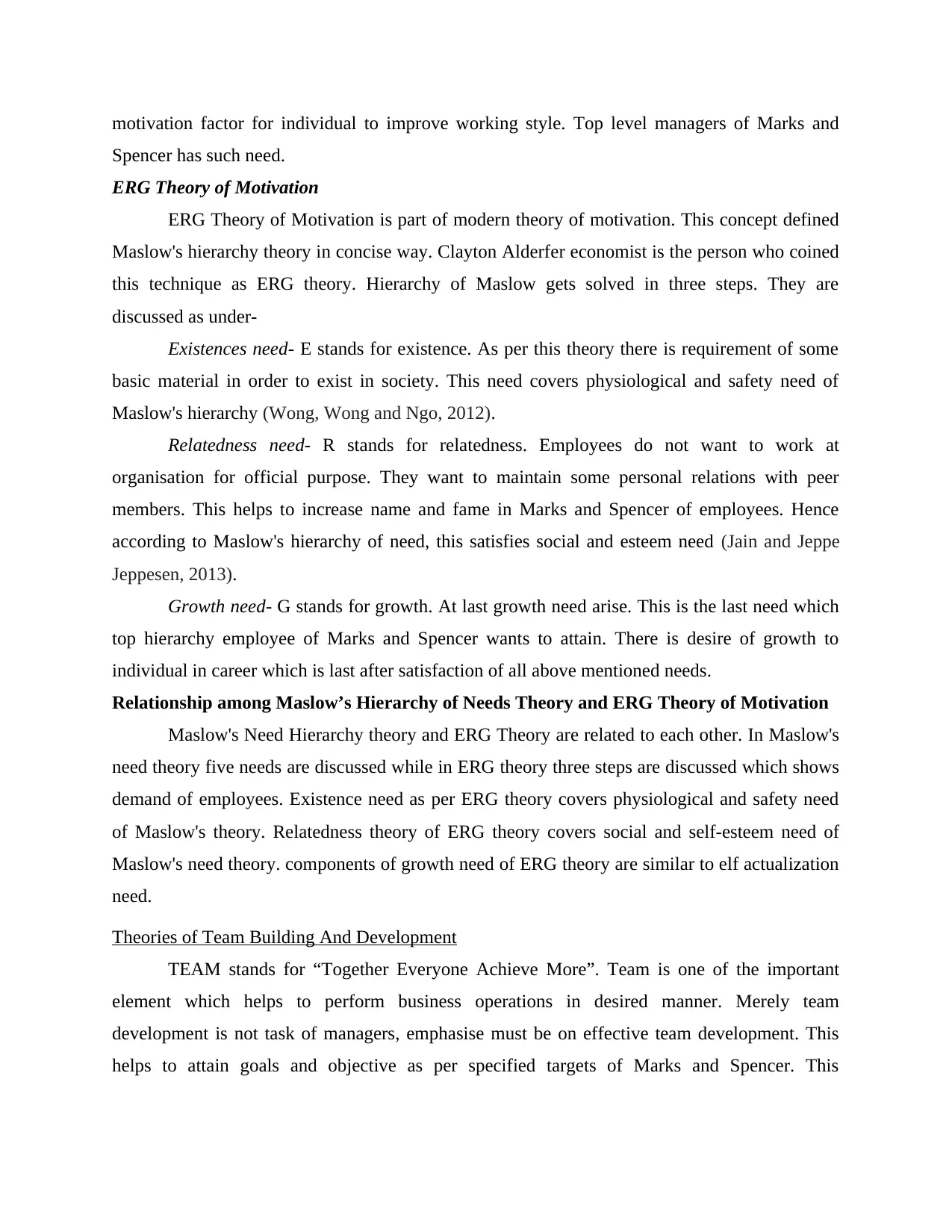
motivation factor for individual to improve working style. Top level managers of Marks and
Spencer has such need.
ERG Theory of Motivation
ERG Theory of Motivation is part of modern theory of motivation. This concept defined
Maslow's hierarchy theory in concise way. Clayton Alderfer economist is the person who coined
this technique as ERG theory. Hierarchy of Maslow gets solved in three steps. They are
discussed as under-
Existences need- E stands for existence. As per this theory there is requirement of some
basic material in order to exist in society. This need covers physiological and safety need of
Maslow's hierarchy (Wong, Wong and Ngo, 2012).
Relatedness need- R stands for relatedness. Employees do not want to work at
organisation for official purpose. They want to maintain some personal relations with peer
members. This helps to increase name and fame in Marks and Spencer of employees. Hence
according to Maslow's hierarchy of need, this satisfies social and esteem need (Jain and Jeppe
Jeppesen, 2013).
Growth need- G stands for growth. At last growth need arise. This is the last need which
top hierarchy employee of Marks and Spencer wants to attain. There is desire of growth to
individual in career which is last after satisfaction of all above mentioned needs.
Relationship among Maslow’s Hierarchy of Needs Theory and ERG Theory of Motivation
Maslow's Need Hierarchy theory and ERG Theory are related to each other. In Maslow's
need theory five needs are discussed while in ERG theory three steps are discussed which shows
demand of employees. Existence need as per ERG theory covers physiological and safety need
of Maslow's theory. Relatedness theory of ERG theory covers social and self-esteem need of
Maslow's need theory. components of growth need of ERG theory are similar to elf actualization
need.
Theories of Team Building And Development
TEAM stands for “Together Everyone Achieve More”. Team is one of the important
element which helps to perform business operations in desired manner. Merely team
development is not task of managers, emphasise must be on effective team development. This
helps to attain goals and objective as per specified targets of Marks and Spencer. This
Spencer has such need.
ERG Theory of Motivation
ERG Theory of Motivation is part of modern theory of motivation. This concept defined
Maslow's hierarchy theory in concise way. Clayton Alderfer economist is the person who coined
this technique as ERG theory. Hierarchy of Maslow gets solved in three steps. They are
discussed as under-
Existences need- E stands for existence. As per this theory there is requirement of some
basic material in order to exist in society. This need covers physiological and safety need of
Maslow's hierarchy (Wong, Wong and Ngo, 2012).
Relatedness need- R stands for relatedness. Employees do not want to work at
organisation for official purpose. They want to maintain some personal relations with peer
members. This helps to increase name and fame in Marks and Spencer of employees. Hence
according to Maslow's hierarchy of need, this satisfies social and esteem need (Jain and Jeppe
Jeppesen, 2013).
Growth need- G stands for growth. At last growth need arise. This is the last need which
top hierarchy employee of Marks and Spencer wants to attain. There is desire of growth to
individual in career which is last after satisfaction of all above mentioned needs.
Relationship among Maslow’s Hierarchy of Needs Theory and ERG Theory of Motivation
Maslow's Need Hierarchy theory and ERG Theory are related to each other. In Maslow's
need theory five needs are discussed while in ERG theory three steps are discussed which shows
demand of employees. Existence need as per ERG theory covers physiological and safety need
of Maslow's theory. Relatedness theory of ERG theory covers social and self-esteem need of
Maslow's need theory. components of growth need of ERG theory are similar to elf actualization
need.
Theories of Team Building And Development
TEAM stands for “Together Everyone Achieve More”. Team is one of the important
element which helps to perform business operations in desired manner. Merely team
development is not task of managers, emphasise must be on effective team development. This
helps to attain goals and objective as per specified targets of Marks and Spencer. This
Paraphrase This Document
Need a fresh take? Get an instant paraphrase of this document with our AI Paraphraser
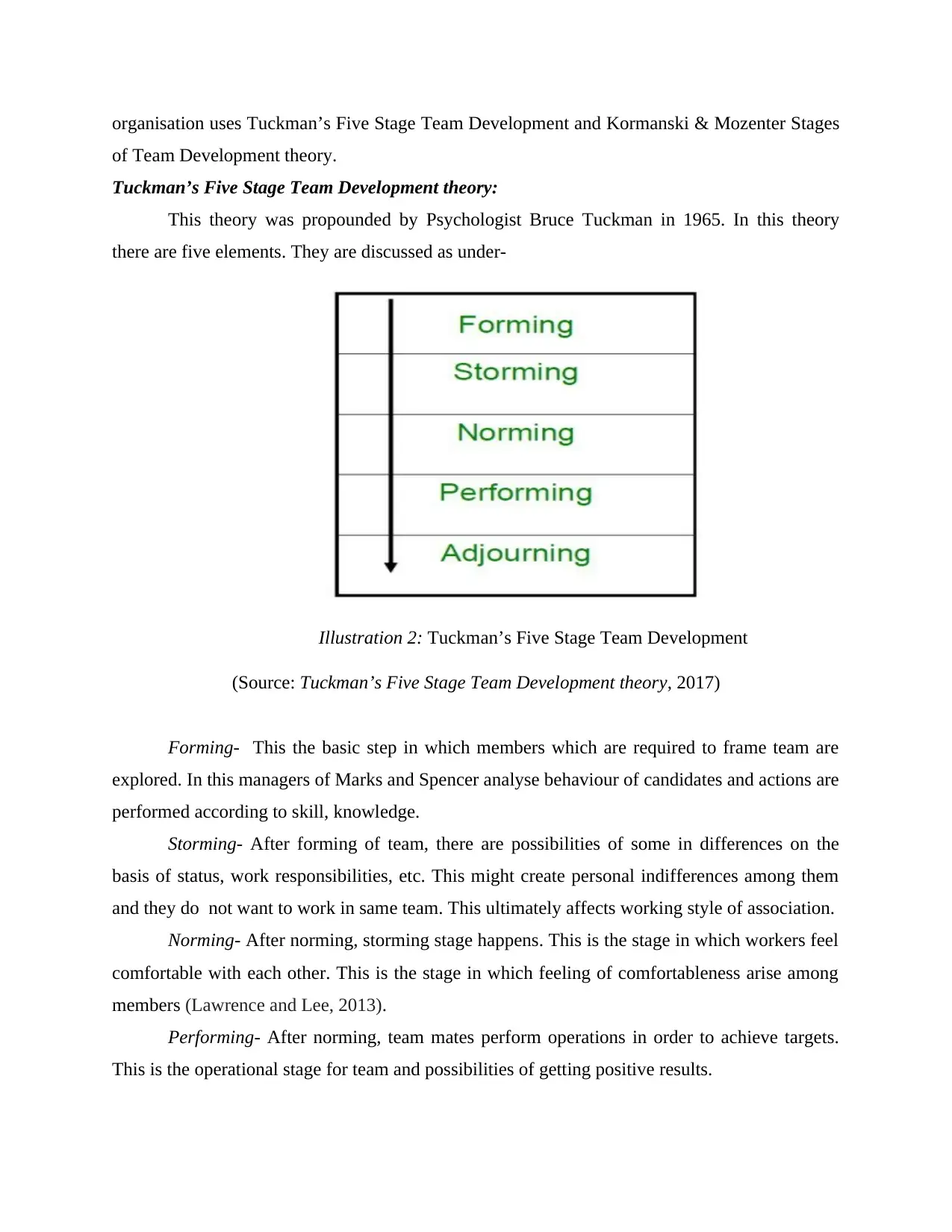
organisation uses Tuckman’s Five Stage Team Development and Kormanski & Mozenter Stages
of Team Development theory.
Tuckman’s Five Stage Team Development theory:
This theory was propounded by Psychologist Bruce Tuckman in 1965. In this theory
there are five elements. They are discussed as under-
(Source: Tuckman’s Five Stage Team Development theory, 2017)
Forming- This the basic step in which members which are required to frame team are
explored. In this managers of Marks and Spencer analyse behaviour of candidates and actions are
performed according to skill, knowledge.
Storming- After forming of team, there are possibilities of some in differences on the
basis of status, work responsibilities, etc. This might create personal indifferences among them
and they do not want to work in same team. This ultimately affects working style of association.
Norming- After norming, storming stage happens. This is the stage in which workers feel
comfortable with each other. This is the stage in which feeling of comfortableness arise among
members (Lawrence and Lee, 2013).
Performing- After norming, team mates perform operations in order to achieve targets.
This is the operational stage for team and possibilities of getting positive results.
Illustration 2: Tuckman’s Five Stage Team Development
of Team Development theory.
Tuckman’s Five Stage Team Development theory:
This theory was propounded by Psychologist Bruce Tuckman in 1965. In this theory
there are five elements. They are discussed as under-
(Source: Tuckman’s Five Stage Team Development theory, 2017)
Forming- This the basic step in which members which are required to frame team are
explored. In this managers of Marks and Spencer analyse behaviour of candidates and actions are
performed according to skill, knowledge.
Storming- After forming of team, there are possibilities of some in differences on the
basis of status, work responsibilities, etc. This might create personal indifferences among them
and they do not want to work in same team. This ultimately affects working style of association.
Norming- After norming, storming stage happens. This is the stage in which workers feel
comfortable with each other. This is the stage in which feeling of comfortableness arise among
members (Lawrence and Lee, 2013).
Performing- After norming, team mates perform operations in order to achieve targets.
This is the operational stage for team and possibilities of getting positive results.
Illustration 2: Tuckman’s Five Stage Team Development
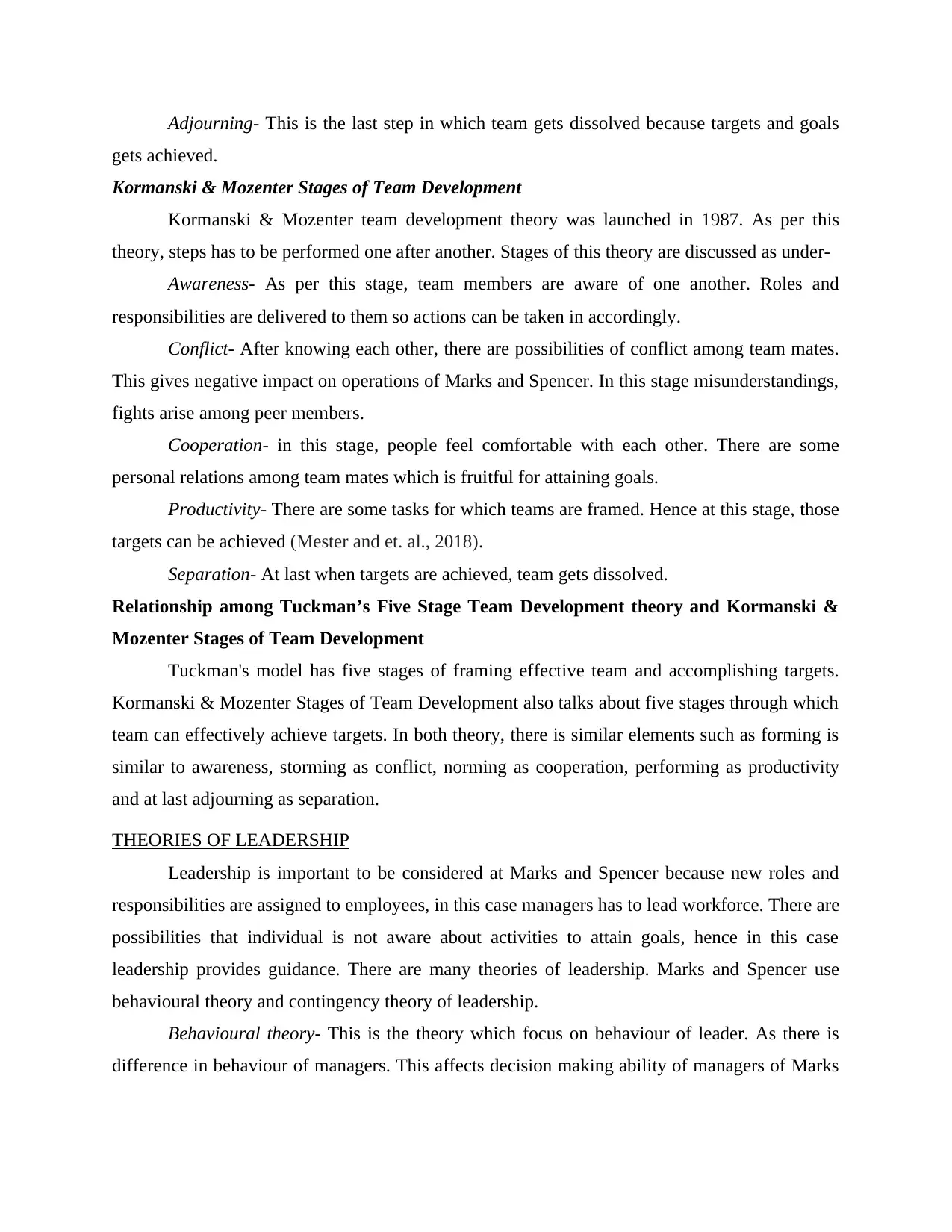
Adjourning- This is the last step in which team gets dissolved because targets and goals
gets achieved.
Kormanski & Mozenter Stages of Team Development
Kormanski & Mozenter team development theory was launched in 1987. As per this
theory, steps has to be performed one after another. Stages of this theory are discussed as under-
Awareness- As per this stage, team members are aware of one another. Roles and
responsibilities are delivered to them so actions can be taken in accordingly.
Conflict- After knowing each other, there are possibilities of conflict among team mates.
This gives negative impact on operations of Marks and Spencer. In this stage misunderstandings,
fights arise among peer members.
Cooperation- in this stage, people feel comfortable with each other. There are some
personal relations among team mates which is fruitful for attaining goals.
Productivity- There are some tasks for which teams are framed. Hence at this stage, those
targets can be achieved (Mester and et. al., 2018).
Separation- At last when targets are achieved, team gets dissolved.
Relationship among Tuckman’s Five Stage Team Development theory and Kormanski &
Mozenter Stages of Team Development
Tuckman's model has five stages of framing effective team and accomplishing targets.
Kormanski & Mozenter Stages of Team Development also talks about five stages through which
team can effectively achieve targets. In both theory, there is similar elements such as forming is
similar to awareness, storming as conflict, norming as cooperation, performing as productivity
and at last adjourning as separation.
THEORIES OF LEADERSHIP
Leadership is important to be considered at Marks and Spencer because new roles and
responsibilities are assigned to employees, in this case managers has to lead workforce. There are
possibilities that individual is not aware about activities to attain goals, hence in this case
leadership provides guidance. There are many theories of leadership. Marks and Spencer use
behavioural theory and contingency theory of leadership.
Behavioural theory- This is the theory which focus on behaviour of leader. As there is
difference in behaviour of managers. This affects decision making ability of managers of Marks
gets achieved.
Kormanski & Mozenter Stages of Team Development
Kormanski & Mozenter team development theory was launched in 1987. As per this
theory, steps has to be performed one after another. Stages of this theory are discussed as under-
Awareness- As per this stage, team members are aware of one another. Roles and
responsibilities are delivered to them so actions can be taken in accordingly.
Conflict- After knowing each other, there are possibilities of conflict among team mates.
This gives negative impact on operations of Marks and Spencer. In this stage misunderstandings,
fights arise among peer members.
Cooperation- in this stage, people feel comfortable with each other. There are some
personal relations among team mates which is fruitful for attaining goals.
Productivity- There are some tasks for which teams are framed. Hence at this stage, those
targets can be achieved (Mester and et. al., 2018).
Separation- At last when targets are achieved, team gets dissolved.
Relationship among Tuckman’s Five Stage Team Development theory and Kormanski &
Mozenter Stages of Team Development
Tuckman's model has five stages of framing effective team and accomplishing targets.
Kormanski & Mozenter Stages of Team Development also talks about five stages through which
team can effectively achieve targets. In both theory, there is similar elements such as forming is
similar to awareness, storming as conflict, norming as cooperation, performing as productivity
and at last adjourning as separation.
THEORIES OF LEADERSHIP
Leadership is important to be considered at Marks and Spencer because new roles and
responsibilities are assigned to employees, in this case managers has to lead workforce. There are
possibilities that individual is not aware about activities to attain goals, hence in this case
leadership provides guidance. There are many theories of leadership. Marks and Spencer use
behavioural theory and contingency theory of leadership.
Behavioural theory- This is the theory which focus on behaviour of leader. As there is
difference in behaviour of managers. This affects decision making ability of managers of Marks
⊘ This is a preview!⊘
Do you want full access?
Subscribe today to unlock all pages.

Trusted by 1+ million students worldwide
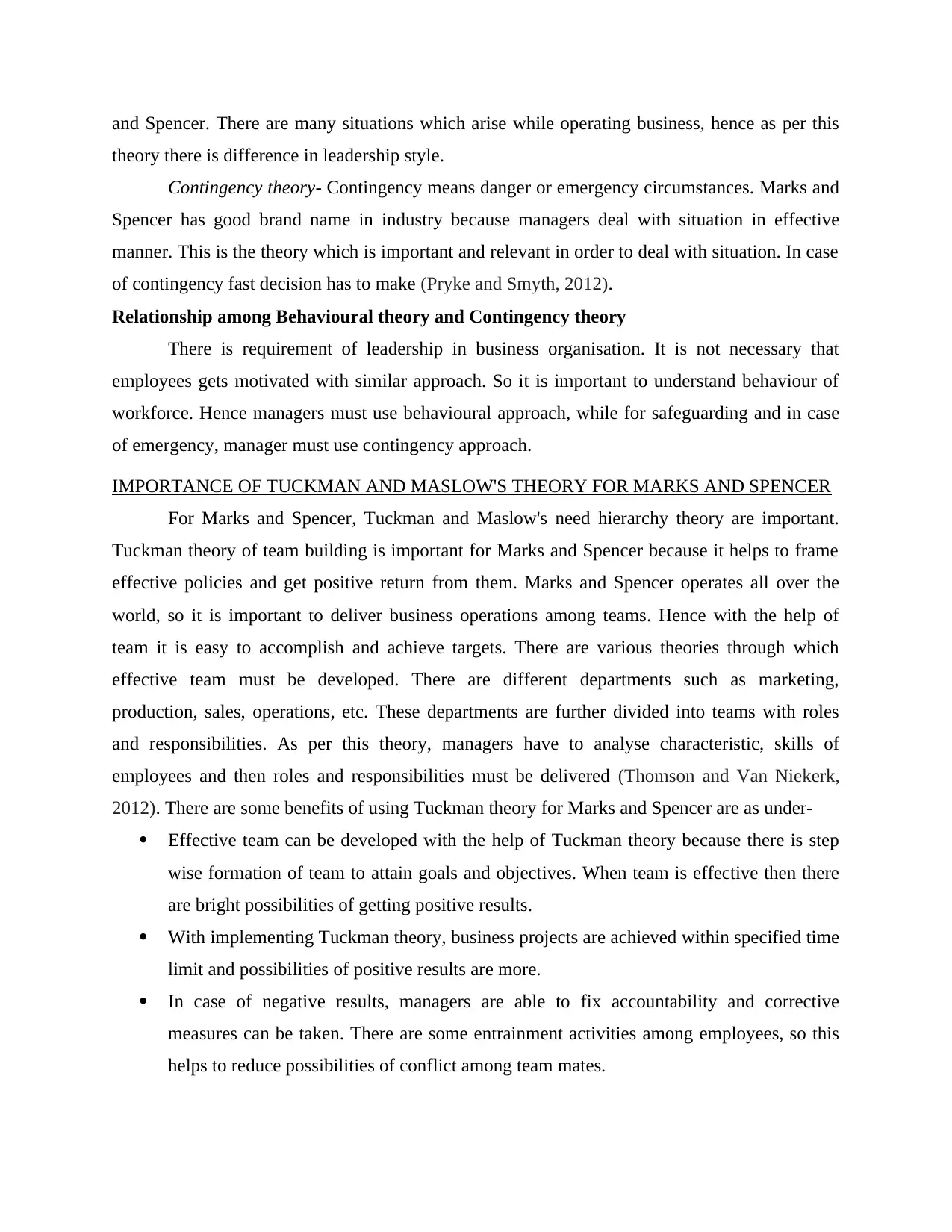
and Spencer. There are many situations which arise while operating business, hence as per this
theory there is difference in leadership style.
Contingency theory- Contingency means danger or emergency circumstances. Marks and
Spencer has good brand name in industry because managers deal with situation in effective
manner. This is the theory which is important and relevant in order to deal with situation. In case
of contingency fast decision has to make (Pryke and Smyth, 2012).
Relationship among Behavioural theory and Contingency theory
There is requirement of leadership in business organisation. It is not necessary that
employees gets motivated with similar approach. So it is important to understand behaviour of
workforce. Hence managers must use behavioural approach, while for safeguarding and in case
of emergency, manager must use contingency approach.
IMPORTANCE OF TUCKMAN AND MASLOW'S THEORY FOR MARKS AND SPENCER
For Marks and Spencer, Tuckman and Maslow's need hierarchy theory are important.
Tuckman theory of team building is important for Marks and Spencer because it helps to frame
effective policies and get positive return from them. Marks and Spencer operates all over the
world, so it is important to deliver business operations among teams. Hence with the help of
team it is easy to accomplish and achieve targets. There are various theories through which
effective team must be developed. There are different departments such as marketing,
production, sales, operations, etc. These departments are further divided into teams with roles
and responsibilities. As per this theory, managers have to analyse characteristic, skills of
employees and then roles and responsibilities must be delivered (Thomson and Van Niekerk,
2012). There are some benefits of using Tuckman theory for Marks and Spencer are as under-
Effective team can be developed with the help of Tuckman theory because there is step
wise formation of team to attain goals and objectives. When team is effective then there
are bright possibilities of getting positive results.
With implementing Tuckman theory, business projects are achieved within specified time
limit and possibilities of positive results are more.
In case of negative results, managers are able to fix accountability and corrective
measures can be taken. There are some entrainment activities among employees, so this
helps to reduce possibilities of conflict among team mates.
theory there is difference in leadership style.
Contingency theory- Contingency means danger or emergency circumstances. Marks and
Spencer has good brand name in industry because managers deal with situation in effective
manner. This is the theory which is important and relevant in order to deal with situation. In case
of contingency fast decision has to make (Pryke and Smyth, 2012).
Relationship among Behavioural theory and Contingency theory
There is requirement of leadership in business organisation. It is not necessary that
employees gets motivated with similar approach. So it is important to understand behaviour of
workforce. Hence managers must use behavioural approach, while for safeguarding and in case
of emergency, manager must use contingency approach.
IMPORTANCE OF TUCKMAN AND MASLOW'S THEORY FOR MARKS AND SPENCER
For Marks and Spencer, Tuckman and Maslow's need hierarchy theory are important.
Tuckman theory of team building is important for Marks and Spencer because it helps to frame
effective policies and get positive return from them. Marks and Spencer operates all over the
world, so it is important to deliver business operations among teams. Hence with the help of
team it is easy to accomplish and achieve targets. There are various theories through which
effective team must be developed. There are different departments such as marketing,
production, sales, operations, etc. These departments are further divided into teams with roles
and responsibilities. As per this theory, managers have to analyse characteristic, skills of
employees and then roles and responsibilities must be delivered (Thomson and Van Niekerk,
2012). There are some benefits of using Tuckman theory for Marks and Spencer are as under-
Effective team can be developed with the help of Tuckman theory because there is step
wise formation of team to attain goals and objectives. When team is effective then there
are bright possibilities of getting positive results.
With implementing Tuckman theory, business projects are achieved within specified time
limit and possibilities of positive results are more.
In case of negative results, managers are able to fix accountability and corrective
measures can be taken. There are some entrainment activities among employees, so this
helps to reduce possibilities of conflict among team mates.
Paraphrase This Document
Need a fresh take? Get an instant paraphrase of this document with our AI Paraphraser
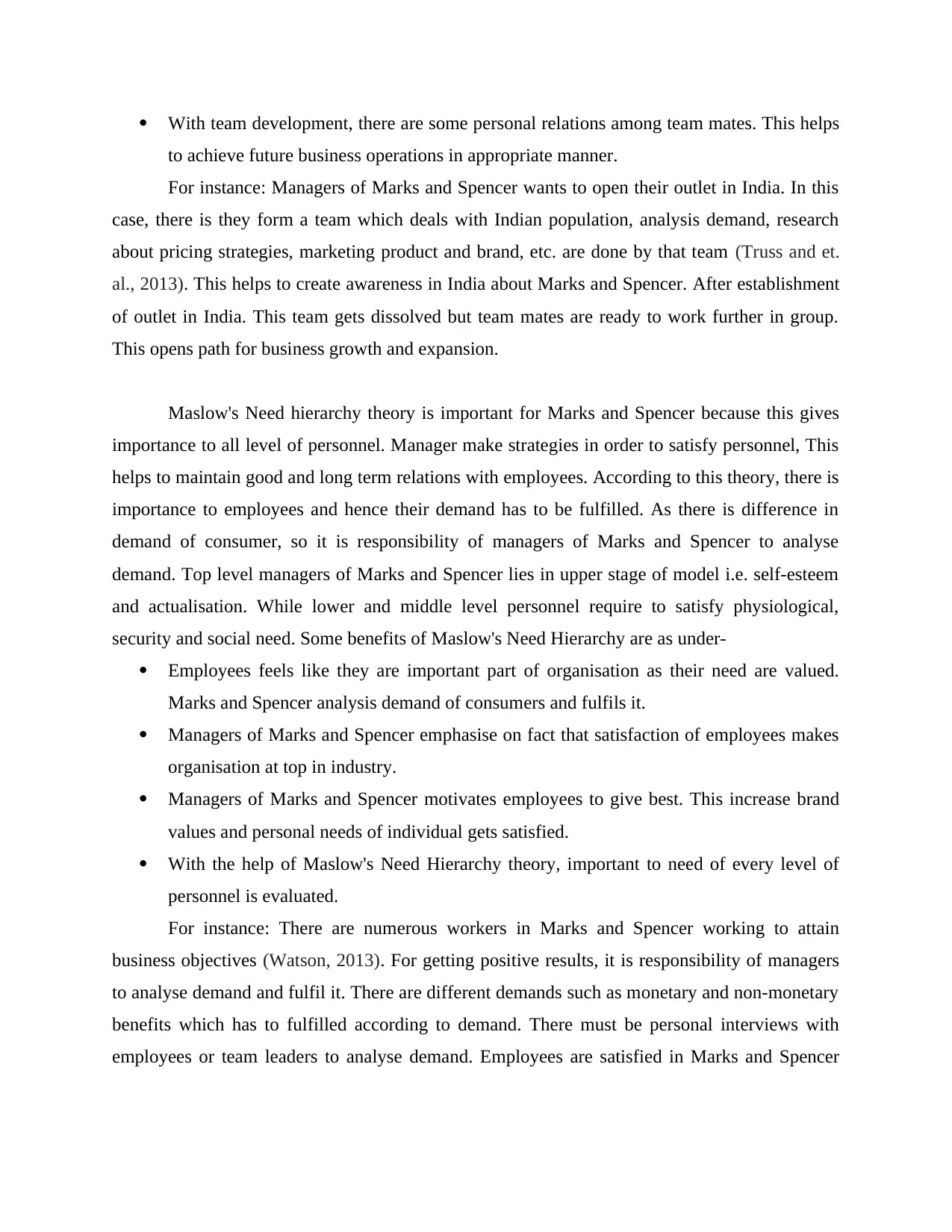
With team development, there are some personal relations among team mates. This helps
to achieve future business operations in appropriate manner.
For instance: Managers of Marks and Spencer wants to open their outlet in India. In this
case, there is they form a team which deals with Indian population, analysis demand, research
about pricing strategies, marketing product and brand, etc. are done by that team (Truss and et.
al., 2013). This helps to create awareness in India about Marks and Spencer. After establishment
of outlet in India. This team gets dissolved but team mates are ready to work further in group.
This opens path for business growth and expansion.
Maslow's Need hierarchy theory is important for Marks and Spencer because this gives
importance to all level of personnel. Manager make strategies in order to satisfy personnel, This
helps to maintain good and long term relations with employees. According to this theory, there is
importance to employees and hence their demand has to be fulfilled. As there is difference in
demand of consumer, so it is responsibility of managers of Marks and Spencer to analyse
demand. Top level managers of Marks and Spencer lies in upper stage of model i.e. self-esteem
and actualisation. While lower and middle level personnel require to satisfy physiological,
security and social need. Some benefits of Maslow's Need Hierarchy are as under-
Employees feels like they are important part of organisation as their need are valued.
Marks and Spencer analysis demand of consumers and fulfils it.
Managers of Marks and Spencer emphasise on fact that satisfaction of employees makes
organisation at top in industry.
Managers of Marks and Spencer motivates employees to give best. This increase brand
values and personal needs of individual gets satisfied.
With the help of Maslow's Need Hierarchy theory, important to need of every level of
personnel is evaluated.
For instance: There are numerous workers in Marks and Spencer working to attain
business objectives (Watson, 2013). For getting positive results, it is responsibility of managers
to analyse demand and fulfil it. There are different demands such as monetary and non-monetary
benefits which has to fulfilled according to demand. There must be personal interviews with
employees or team leaders to analyse demand. Employees are satisfied in Marks and Spencer
to achieve future business operations in appropriate manner.
For instance: Managers of Marks and Spencer wants to open their outlet in India. In this
case, there is they form a team which deals with Indian population, analysis demand, research
about pricing strategies, marketing product and brand, etc. are done by that team (Truss and et.
al., 2013). This helps to create awareness in India about Marks and Spencer. After establishment
of outlet in India. This team gets dissolved but team mates are ready to work further in group.
This opens path for business growth and expansion.
Maslow's Need hierarchy theory is important for Marks and Spencer because this gives
importance to all level of personnel. Manager make strategies in order to satisfy personnel, This
helps to maintain good and long term relations with employees. According to this theory, there is
importance to employees and hence their demand has to be fulfilled. As there is difference in
demand of consumer, so it is responsibility of managers of Marks and Spencer to analyse
demand. Top level managers of Marks and Spencer lies in upper stage of model i.e. self-esteem
and actualisation. While lower and middle level personnel require to satisfy physiological,
security and social need. Some benefits of Maslow's Need Hierarchy are as under-
Employees feels like they are important part of organisation as their need are valued.
Marks and Spencer analysis demand of consumers and fulfils it.
Managers of Marks and Spencer emphasise on fact that satisfaction of employees makes
organisation at top in industry.
Managers of Marks and Spencer motivates employees to give best. This increase brand
values and personal needs of individual gets satisfied.
With the help of Maslow's Need Hierarchy theory, important to need of every level of
personnel is evaluated.
For instance: There are numerous workers in Marks and Spencer working to attain
business objectives (Watson, 2013). For getting positive results, it is responsibility of managers
to analyse demand and fulfil it. There are different demands such as monetary and non-monetary
benefits which has to fulfilled according to demand. There must be personal interviews with
employees or team leaders to analyse demand. Employees are satisfied in Marks and Spencer
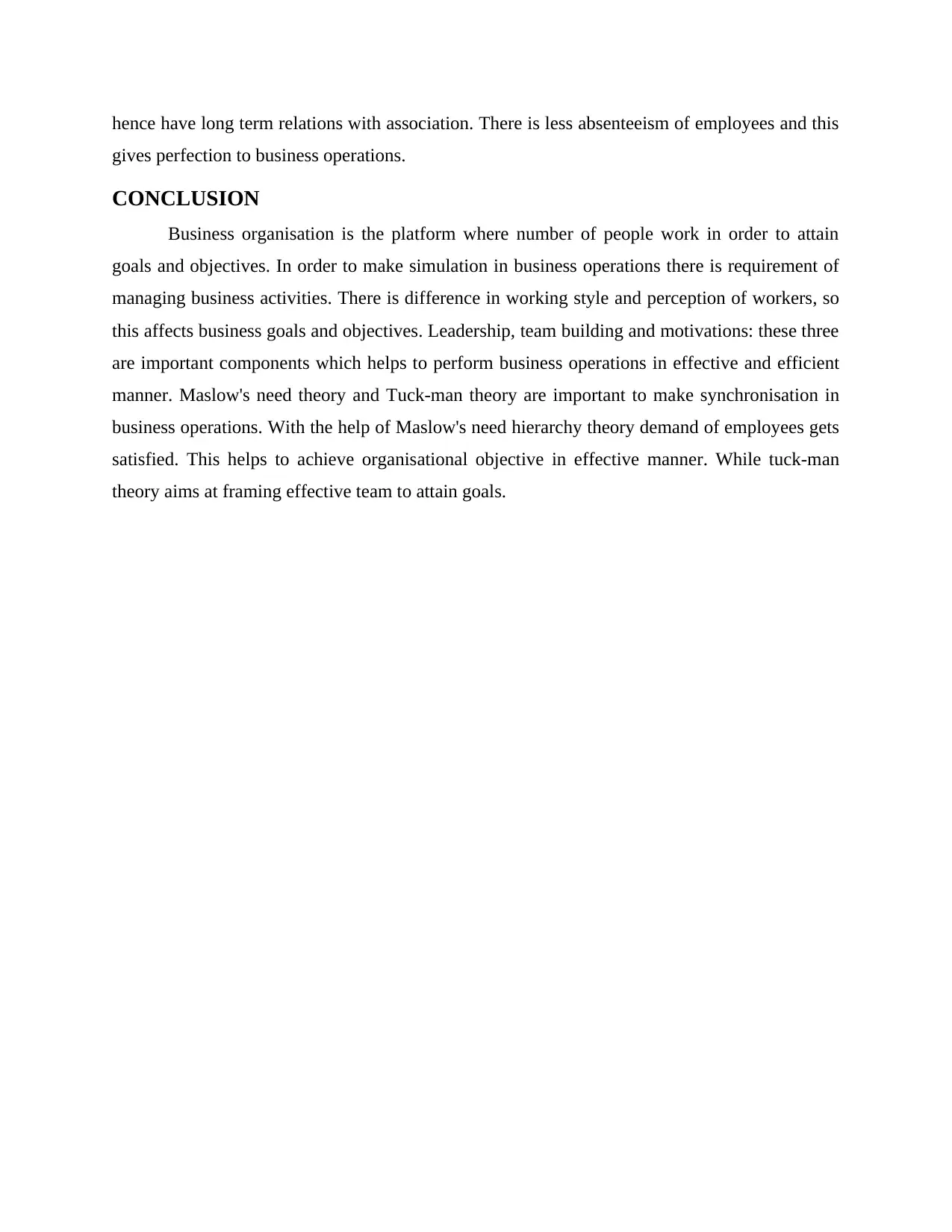
hence have long term relations with association. There is less absenteeism of employees and this
gives perfection to business operations.
CONCLUSION
Business organisation is the platform where number of people work in order to attain
goals and objectives. In order to make simulation in business operations there is requirement of
managing business activities. There is difference in working style and perception of workers, so
this affects business goals and objectives. Leadership, team building and motivations: these three
are important components which helps to perform business operations in effective and efficient
manner. Maslow's need theory and Tuck-man theory are important to make synchronisation in
business operations. With the help of Maslow's need hierarchy theory demand of employees gets
satisfied. This helps to achieve organisational objective in effective manner. While tuck-man
theory aims at framing effective team to attain goals.
gives perfection to business operations.
CONCLUSION
Business organisation is the platform where number of people work in order to attain
goals and objectives. In order to make simulation in business operations there is requirement of
managing business activities. There is difference in working style and perception of workers, so
this affects business goals and objectives. Leadership, team building and motivations: these three
are important components which helps to perform business operations in effective and efficient
manner. Maslow's need theory and Tuck-man theory are important to make synchronisation in
business operations. With the help of Maslow's need hierarchy theory demand of employees gets
satisfied. This helps to achieve organisational objective in effective manner. While tuck-man
theory aims at framing effective team to attain goals.
⊘ This is a preview!⊘
Do you want full access?
Subscribe today to unlock all pages.

Trusted by 1+ million students worldwide
1 out of 14
Related Documents
Your All-in-One AI-Powered Toolkit for Academic Success.
+13062052269
info@desklib.com
Available 24*7 on WhatsApp / Email
![[object Object]](/_next/static/media/star-bottom.7253800d.svg)
Unlock your academic potential
Copyright © 2020–2025 A2Z Services. All Rights Reserved. Developed and managed by ZUCOL.




